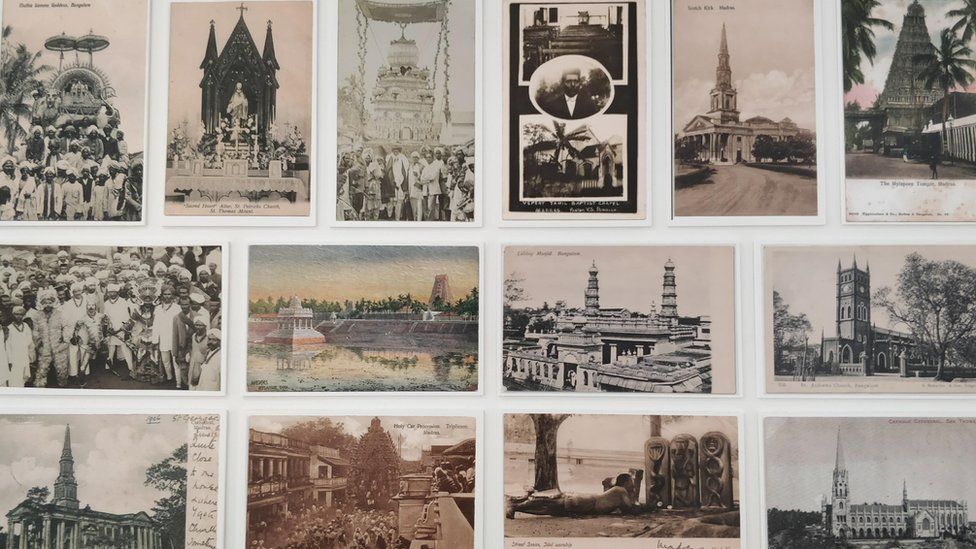
In class: terms on the potential racist continuum.
Racism and stereotypes in colonial India’s 'Instagram’
 STEPHEN PUTNAM HUGHES AND EMILY ROSE STEVENSON
STEPHEN PUTNAM HUGHES AND EMILY ROSE STEVENSON
In the early 20th Century, picture postcards served as a kind of Instagram, giving Europeans a glimpse of the life their family and friends led in British colonial India.
A recent exhibition at London's SOAS university showcased more than 1,000 such postcards that were sent from India to Europe between 1900 and the 1930s.
"We don't want the postcards to be a vehicle of colonial nostalgia. It is the opposite of that," Stephen Putnam Hughes, a co-curator of the exhibition told the BBC. "We wanted to provide enough evidence from the colonial past and allow people to look at the images critically."
This display was drawn from the private collection of Dr Hughes and Emily Rose Stevenson. They bought postcards on websites such as eBay, and at ephemera fairs, which sell things like antique and second hand books, and manuscripts.
 STEPHEN PUTNAM HUGHES AND EMILY ROSE STEVENSON
STEPHEN PUTNAM HUGHES AND EMILY ROSE STEVENSON
It was a popular way to communicate back then - more than six billion postcards passed through the British postal system between 1902 and 1910, according to the exhibition's organisers.
"Postcards did for photography what printing did for literacy," Dr Hughes says. "Photographs were not affordable back then but picture postcards were much cheaper and mass produced."
Picture postcards of streets as well as public buildings were popular. Their visual aesthetic was similar to the paintings of the time.
They reflected British understanding and planning of cities in India, which was based on European distinctions between public and private space, and divisions between Indian and European populations.
One set of postcards belonged to a popular series, called Masters, produced by a Chennai-based publisher in the early 1900s.
It was meant as a "humorous" comment on the master-servant relationship at the heart of British rule in India, according to the note explaining the postcards. But it also played on "British anxieties" and "insecurities" about what the "servant" would do when the "master" was not around.
It was meant as a "humorous" comment on the master-servant relationship at the heart of British rule in India, according to the note explaining the postcards. But it also played on "British anxieties" and "insecurities" about what the "servant" would do when the "master" was not around.
 STEPHEN PUTNAM HUGHES AND EMILY ROSE STEVENSON
STEPHEN PUTNAM HUGHES AND EMILY ROSE STEVENSON
The result: postcards depicting Indians "mocking their masters' lifestyle choices". They are shown drinking beer, smoking and reading with their feet up, all of which "were not equal opportunity activities" at the time.
The same publisher, Higginbothams and Co, produced a controversial series, called Madras Hunt.
The note accompanying the series explained that these images were staged. In each of them, women are shown searching for head lice. The title, Madras Hunt, juxtaposes what they are doing with the British sport of hunting in an attempt at satire.
 STEPHEN PUTNAM HUGHES AND EMILY ROSE STEVENSON
STEPHEN PUTNAM HUGHES AND EMILY ROSE STEVENSON
The curators say the series was both provocative and demeaning - it often prompted people to respond to the image with racist jokes.
It was also commercially one of the most successful series sold and posted. It was printed in Germany, Italy and England.

"native type"
Indians performing menial jobs for Europeans were also a common feature of these postcards.
 STEPHEN PUTNAM HUGHES AND EMILY ROSE STEVENSON
STEPHEN PUTNAM HUGHES AND EMILY ROSE STEVENSON
This one, titled The Morning Tub, was published early in the 20th century and shows that Europeans often had help waiting on them while they bathed.
"While Indians did all the work in postcards, Europeans living in Madras and Bangalore were rarely pictured unless they were being served or enjoying leisure time," the curators note.

For some Europeans who didn't have the means to hire domestic help back home, these postcards served as evidence of their elevated status in British India.
So, some of the postcards show people solely identified by their occupation - in this case, the "dhoby" or washerman who regularly collected clothes for wash from several homes.
"Postcards certainly reinforced European stereotypes of Indians and contributed to the construction of fixed, defined characteristics of particular groups," Dr Hughes says.
"Decolonisation cannot be done once and for all," Dr Hughes says. "It is a continuous process, and each person has to do it for themselves. We hope that people were able to do that through this exhibition."
Please read the following 5 pages carefully, noting especially the terms:
1. stereotype, 2. prejudice, 3. bias and 4. discrimination.
As you carefully, read through the following five pages of
text, please define these terms: stereotype, prejudice,
bias and discrimination. They have specific meanings
and are not interchangeable. It is important that you use
these terms correctly.
To emphasize their importance and to ensure that you
understand the difference, please send me a word
document with the word and its definition, as you would paraphrase the term. That means do not simply copy.
(class participation grade).
The readings can be enlarged for easier visibility.











No comments:
Post a Comment